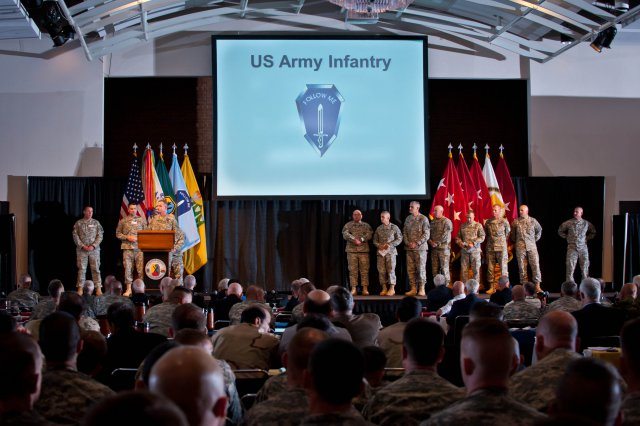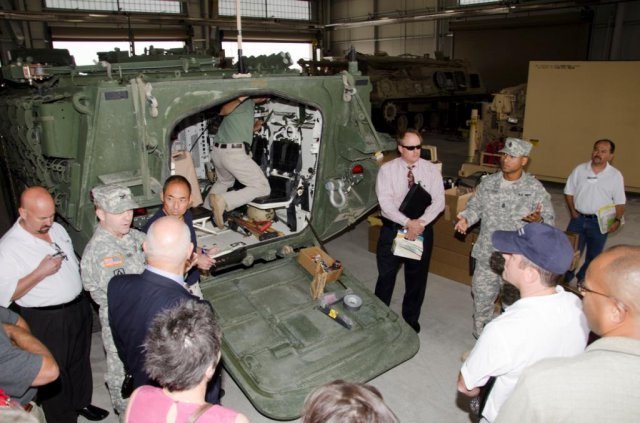The chiefs of Armor and Infantry delivered updates on their respective branches Tuesday at the Maneuver Conference.
Col. Walter Piatt, the Infantry School commandant, and Col. Tom James, who heads the Armor School, spoke about the outcomes-based training taking place within each schoolhouse at Fort Benning’s Maneuver Center of Excellence. They said building a combined-arms team for decisive action is a major facet of 21st-century maneuver training.
“It’s about Armor and Infantry working together, with Cavalry eyes on the objective,” James said during his speech at the Columbus Georgia Convention and Trade Center. “For us, it’s about supporting the Infantry in that last 100 yards. It’s getting positional advantage to dominate our enemy, and the combination is unstoppable.”
The 46th chief of Armor praised the efforts that went into moving the Armor School to Fort Benning after a seven-decade stint at Fort Knox, Ky. He said the “functional training” opportunities under the MCoE are boundless.
“We’ve put ourselves in a neat position on the maneuver team,” he said. “We’re excited to be a part of it.”
Piatt, who arrived at Fort Benning this summer, said Army transformation has dramatically altered the look and energy on post, compared to a couple of decades ago.
“But some things have not changed — we make Infantrymen, and we make Infantrymen better,” he said. “The Infantry has got to be ready today and relevant no matter what the future holds.”
Piatt said the large gathering of past and current generals at the Maneuver Conference offers a solid opportunity to share lessons learned, tactics, techniques and procedures from across the Army. He’s been an Infantryman since 1979 but said he’s never attended a conference of this magnitude.
“This is powerful,” he said. “The Maneuver Center has the lead for initiatives such as 21st-century leader development and ‘Squad as a Strategic Formation.’ We’re the ones who have to solve our future security concerns. That’s what conferences like this allow.”
Tuesday’s Infantry update included brief presentations by leaders from the 197th, 198th and 199th Infantry brigades, as well as the Ranger Training Brigade.
In fiscal year 2010, the 198th Infantry Brigade produced 19,205 Infantrymen and the numbers are expected to top 20,000 in the next year, said Col. Bruce Parker, the unit’s commander. Twenty-six companies are in cycle right now on Sand Hill.
Officials said a decrease is projected for the Airborne School, where graduates in the Basic Airborne Course are forecast to drop from more than 18,000 to just under 13,800 in the coming fiscal year.
The Ranger Training Brigade continues to face a shortage of Ranger-qualified junior noncommissioned officers, said RTB Command Sgt. Maj. Dennis Smith. The unit is only filling about a quarter of the slots it’s allocated by the Army.
In fiscal year 2010, Ranger School yielded 2,034 graduates, a 47 percent success rate. There have been nearly 1,300 graduates so far this fiscal year at a rate of 42 percent. RTB said it’s aiming for 3,244 graduates in fiscal 2012.
Piatt said he anticipates a reduction in funding for mobile training teams as the operations tempo and pace of Iraq and Afghanistan deployments slows. That means more Soldiers will be sent to Fort Benning for specialized instruction.
“We can provide a better training product here,” he said. “That also should save money and make it more cost-effective for the Army.”
James said the war on terror has changed Armor formations. During the Cold War, it was 60 percent Armor and 40 percent Cavalry. The opposite is true today, he said.
But mobility, protection and firepower remain the key capabilities Armor brings to the fight, he said.
“We’ve got to be able to make decisions at 15 (kilometers an hour) and faster,” he said. “We want to act on contact, not react on contact.”
Among several initiatives, the Armor School is engaged in an M1 tank modernization program, James said.











